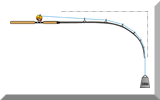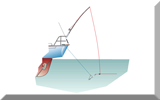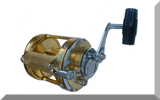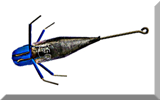- Home
- All About Reels
- Saltwater Spinning Reel
Is the Saltwater Spinning Reel the Ideal Sea Fishing Reel?
It's a very forgiving piece of kit, the saltwater spinning reel. As long as it's properly loaded with line and matched to an appropriate rod, long casting - even to the novice angler - will come quickly and easily.
Unlike traditional reels (or multiplier reels) the spinning reel's spool is orientated across the rod, and doesn't rotate - the line just spills over its lip during the cast.
Hence it's alternative name, the 'fixed spool' reel.
As a result, there's no mechanical part of the reel to energize - all of the energy released by the rod is used to power the lure or terminal tackle to seaward.
Using braid of much below 30lb breaking strain on traditional reels can lead to problems with the line jams on the spool, due to the small diameter of braid line.
This is a problem you don't get with spinning reels - and it's due to the oscillating line lay, which you can read about a few paragraphs below.
Spinning Reel Sizes
A decade or so ago, reels of this type were large, clunky affairs - often feeling quite cumbersome as part of a casting outfit. Today's saltwater spinning reels are generally better engineered, lighter and more compact.
Most manufacturers produce each of their models in several different sizes, often using categories roughly equating to similar capacity baitcast reels from 2000 through to 10000.
Take the excellent PENN Spinfisher VI Spinning Reel for example.
This model is produced in seven sizes, from a small 3500 through to the largest model 9500.
It's worth comparing the properties of the smallest and largest models. But what does it all mean?
.Spool Capacity (Mono): Spool Capacity (Braid): Ball Bearings: Maximum Drag: Gear Ratio: Recovery: Reel Weight (oz): |
SSV35006lb/250yds 15lb/215yds 5+1 20lbs 6.2:1 30 inches 14.4oz |
SSV9500
40lb/300yds 65lb/540yds 5+1 40lbs 4.2:1 39 inches 41.9oz |
Spool Capacity
Gone are the days when saltwater spinning reel spools were so deep that they had to be loaded with miles of backing line. Now they are much shallower and profiled to suit the line size they're intended for.
Many reel manufacturers include a second spool in the price, so when you're comparing like-for-like models on a cost basis it's worth taking this into account. Changing spools can be done in a matter of seconds. There's no screws to worry about, just a single push-button.
Most anglers will find that two carefully selected saltwater spinning reels, together with a second spool for each and loaded with a different line size (and maybe line type), will meet all of their needs. It will be very useful if they can, as good quality saltwater spinning reels don't come cheap...
Reel size and line capacity are closely related, and are usually quoted in dia(mm)/capacity(m) and breaking strain(lb)/capacity(yds) for both nylon monofilament and the much thinner braid line.
Whichever type of line you use, you should fill the spool almost to the brim for maximum casting range.
Ball Bearings
Ball bearings will are necessary to give the main spindle stability and smoothness; any spinning reel worth its salt will have at least 2 sets.
The reel shown above is particularly well catered for with 10. Incidentally, the '+1' relates to the roller bearing, rather than a plain rotating bush on the bale arm. This is essential if line wear is to be avoided as the bale arm wraps the line around the fixed spool.
Maximum Drag
Drag is adjusted by a knob on either the front of the reel or the back. The front drag system is preferred for saltwater fishing as it's more directly applied to the spool and is consequently more powerful than a rear drag system. The larger the reel and the more powerful the fish, the more a front drag system will be appreciated.
In the example reel above, it will come as no surprise that the larger reel has the more powerful drag.
Gear Ratio and Recovery
The gear ration tells us the number of times the bale arm will rotate for each turn of the handle. Clearly the larger the spool diameter the greater the length of line that will be recovered for each turn of the spool.
Put another way, line recovery is related to the gear ratio and spool diameter
You can see that although the gear ration of the larger spinning reel is less than that of the smaller one, its rate of line recovery is much higher.
Caring for Your Saltwater Spinning Reel
Saltwater spinning reels are very robust and require little maintenance. However the following regime will ensure long-term reliability ...
- After a day's seafishing, swill your spinning reel (or any other type of fishing reel) with fresh water and release the pressure on the drag. A regular spray of moisture repelling lubricant will do no harm at all.
- Every few weeks lightly oil or grease the reel's external moving parts, particularly the handles, the bale arm movement points and the roller.
- At least once a year dismantle the reel and thoroughly clean the various parts, then lubricate with light machine oil or a dab of reel lubricant, and carefully reassemble.
Looked after in this way, a high quality spinning reel may well last you a lifetime.
Recent Articles
-
Sea Fishing Rods and Reels Must Be Compatible for a Balanced Outfit
Mar 08, 21 08:30 AM
A quality reel fitted to a quality rod doesn't necessarily make it a quality outfit. Your fishing rods and reels have to be properly matched if you're to get the best out of them, and here’s how -
Essential Lure Fishing Tips That All Saltwater Anglers Should Know
Mar 08, 21 04:51 AM
Which single lure fishing tip applies to trolling, jigging, baitcasting, spinning, fly fishing and any other branch of lure fishing? Well, it is the one at the top of this list -
Vital Jig Fishing Tips That You Really Cannot Afford To Miss!
Mar 07, 21 10:20 AM
Essential jig fishing tips to help you select the right lure for successful jig fishing, together with the techniques required to get the most out of your jig fishing outfit

























New! Comments
Have your say about what you've just read! Leave me a comment in the box below.